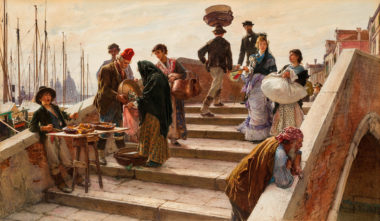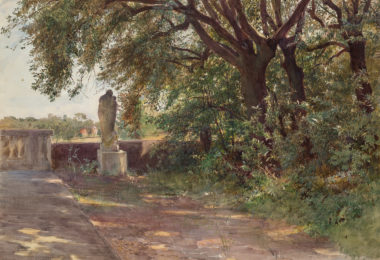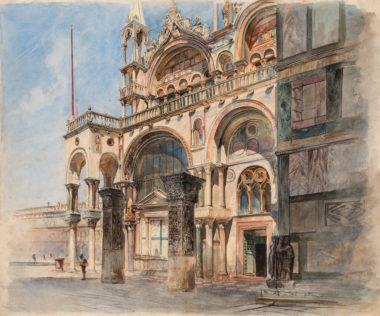Passini, Ludwig
Sold Artworks
Biography
Ludwig Passini
1832 Vienna – 1903 Venice
The son and pupil of the engraver Johann Nepomuk Passini, Ludwig Passini grew up in Vienna. He possessed early proficiency in painting in watercolour and sketching thanks to his father’s tuition. The decision to specialise in the medium of watercolour was almost certainly prompted by the work of prominent family friends such as Moritz von Schwind, Peter Fendi and Rudolf Alt. Passini very probably also received important stimuli from his father’s contacts to other late-Romantic, Biedermeier and Realist circles.
Passini took up his studies at the Vienna Academy of Art in 1847. But in 1850, the turmoil of the economic crisis triggered by the Revolutions of 1848 obliged the family to relocate to Trieste. Passini soon struck out on his own and moved to Venice, where he entered the studio of the watercolourist Carl Werner. The two artists travelled widely together, undertaking numerous study tours throughout Italy. By the time Passini arrived in Rome in 1853 his formidable artistic talents were fully matured.
Passini’s personal charm and elegance, coupled with cosmopolitan flair, brought him introductions to the highest echelons of Roman society. Among his friends in the community of German-speaking artists were Anselm Feuerbach and Arnold Böcklin. The composer Franz Liszt, who had withdrawn to a monastic life after suffering personal loss, nurtured Passini’s participation in the musical life of Rome and introduced him to high-ranking ecclesiastical figures. Passini met his future wife, Anna Warschauer, the grand-daughter of Alexander Mendelssohn, a Berlin banker, in Rome. They were married in Berlin in 1864 and Anna, with her cultivated artistic sense, eased her husband’s entry into Berlin high society. He soon advanced to be one of the city’s most sought-after portraitists. But in 1866 Anna Passini died in childbirth, a loss from which the sensitive Passini was never fully to recover.
Although Passini enjoyed considerable success in Rome and Berlin, he chose to relegate life in both cities to the past. He moved to Venice in 1873 and spent his final years living in a palazzo on the Canale Grande. He continued to produce paintings and watercolours but developed a predilection for architectural motifs and Venetian genre scenes which earned him a large following throughout Europe. He exhibited his work widely and was named a member of the Academy of Fine Arts in Vienna, the Royal Academy of the Arts in Berlin and the Accademia di Belle Arti in Venice.
Like few other artists of his time Passini knew how to exploit the full technical and colouristic potential of watercolour. He was an equally gifted painter of an intimate nature study and a highly finished composition. His aim was always to capture the inner essence of the motif and portray it with maximum authenticity. He is justifiably regarded as one of the nineteenth century’s most virtuoso watercolourists, achieving seemingly effortless transitions from a fluidly applied wet-on-wet technique to sumptuous, finely worked detail. The remarkable appeal of his work lies in his choice of motifs – the majority are drawn from the city of Venice with its unique topography and world-famous architectural monuments – a place like no other, laden with the elegance and beauty of impending decay. Passini, like the Englishman John Ruskin before him and the Italian-born John Singer Sargent later, ranks as one of the most notable chroniclers of this extraordinary city and its vast lagoon. To this day, his watercolours convey a vibrant impression of its exceptional beauty.
PDF Download

